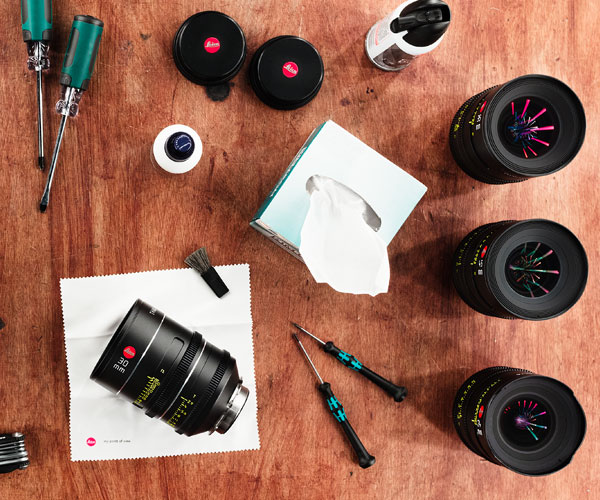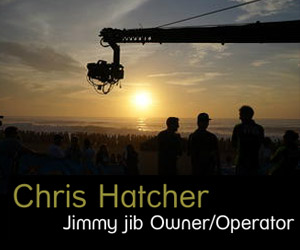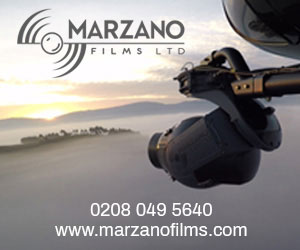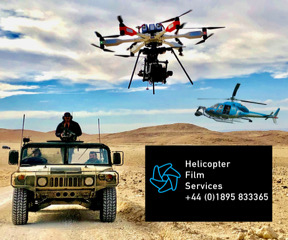Broadcast News
12/04/2018
Few Lens Optics For Decades, Then Came The Large Digital Sensors

As software takes control of virtually every production and delivery function, cameras and lenses have reached the stage of looking magnificent as the last bastion of what we understood as hardware. And with rich metadata emanating backwards into post from every shoot, we have at last reached the glass-to-glass era.
Going into NAB, the lens companies will be trumpeting their unique looks, offering bigger image circles whilst championing the ongoing appeal of S35, and promoting new coatings and ways to resolve stray light.
The many sets of lenses to find include the Arri Signature Primes (and how they relate to the Alexa LF), the Cooke Panchro Classics, The Leica Thalias, The Zeiss C.3 set, and the Fujinon 4K+ optics. Canon too will have exciting lens news, but wished to hold its announcements for NAB. The big appeal will be seeing the new purpose-designed lenses sitting on the RED Weapon, Sony Venice, Arri Alexa and LF, and the Panavision DLX2. And then there is Panavision, and the claim that it offers the widest choice of large format lens options on the market.
Basically, every lens manufacturer has a different philosophy for look, and none are right or wrong.
A shorter back focus
The launch by Arri of the Alexa LF camera system coincided with the appearance its Signature Primes: were they purpose created to get the best out of the camera in terms of shallow focus and dynamic range?
"The Signature Primes are designed for large format cameras with an image circle of approx. 45mm. Since the lifecycle of lenses is very long, these primes should also perform with future sensor generations," said Arri optical systems product manager Thorsten Meywald. "We see a trend for smaller pixel size and more pixels and more dynamic range as well, which requires modern high performance optics.
"We are introducing the Signature Primes together with the ALEXA LF and the new LPL mount as the ARRI LF camera system," he added. "However, the lenses and the mount will stay much longer in the market – because camera lifecycles are shorter. The LF system ARRI is a new format with its own aesthetics. It fills the gap between S35 format and the ALEXA 65. Cinematographers get a look which is closer to the ALEXA65."
The LF system will find credits in feature films, TV drama, and commercials. The primes will match well to the Alexa Mini, and loads of other cameras, from the likes of Sony and RED.
"Our philosophy is to make products users can mix and match on set. The Signature Primes are lenses with a shorter back focus and this allows for easier adaptation to other camera systems," said Meywald. "We are licensing our technology to other partners in the industry and so far companies like Angénieux, Cooke, Zeiss, Leica, Vantage, and Panavision have already adopted our technology."
Cinematographers (also) allocate a mythical 'look' to lenses per company, so with the Signature Primes how does Meywald define that look?
He said: "They have all the benefits we know from MP and UP, but are specifically designed for digital sensors and the aesthetics of human skin tones.
"Compared to other lenses they are technically very sharp and free of optical aberrations, but at the same time they render skin tones in a very natural and organic way and create a lively image full of dimensionality. It is a modern look, which opens new creative choices. The new primes give back the aesthetics of film without the unwanted artefacts.”
A much more cinematic look
Cooke Optics owner and CEO Les Zellen will take new lenses in both the S7/I purpose-built full frame and Panchro/I Classic ranges to NAB.
The first set is boosted with 16mm, 21mm, 27mm and 65mm, while the Panchro newcomers are the 21mm, 27mm, 65mm Macro and 135mm. The thrill will be to see the S7/I lenses – covering the full sensor area (46.31mm image circle) of the RED Monstro - mounted on the RED Weapon, Sony Venice and Arri Alexa LF.
Zellen had no official warnings from the camera vendors so starting the S7 project was a mater of tracking rumours.
"We started before most of the cameras were developed. We knew about the RED Weapon but the Arri, Venice and other full frame cameras weren't even rumours. It turns out things are a bit good – the lenses are here, the cameras are arriving, and sales are crazy," he said.
"We didn't do anything special – incorporating the Cooke look and obviously making a bigger format. The reason the digital guys like the look of our lenses is that the Cooke look plays very well with the chips, giving a much more cinematic look," he added.
The Cooke look tracks back consistently to the Speed Panchro range from decades ago. Are the new cameras a huge story, or just a set of new options in the DOP toolbox?
"That goes market by market. Last autumn you could not find a film camera anywhere in the USA because they were all working. Full frame has its place, but time will tell," said Zellen. "I still wonder a bit why we are shooting a full frame in higher resolution."
He had in mind young people watching movies on IPads. Will Cooke stay strong with anamorphic?
"We still have plans in that area, and cannot keep up with the demand for our anamorphic series, both regular and SF. To put things in perspective we are still back-ordered on S4s: they are S35/T2 and this is their 20th anniversary," said Zellen.
"S35 is not going anywhere any time soon," he added. "I look at full frame and 65mm, and some people want to shoot with it just because it is there. We are a fashion-driven industry, and I hope that a lot of people use it as another tool in their arsenal, and say: 'Well to tell the story correctly in whatever format it is going to be viewed I can shoot in X, whether that be S35, full frame, Arri 65, 8K, 4K, or 2K. The talk about a gazillion K is just marketing hype'."
The tail wagging the dog equates to people gushing about new tools and vowing to use them on their next story. The Cooke look might be defined as contrast and colour balance, but this does not apply to the Panchro Classics.
"The reason we reviewed the Panchro Classics and the Panchro design is simply because it is what the market wanted. As digital cameras have got sharper and sharper, cinematographers have gone for anamorphic and old Speed Panchro options to help them put personality and character back into their pictures," said Zellen. "Digital can be a pretty sterile image, especially as it gets higher in resolution."
The new Martin Scorsese movie The Irishman was the first big movie to be shot using the new Panchro Classics.
"Dick Pope, who is a real lover of the old Speed Panchro set, was recently starting the movie Motherless Brooklyn and he tested the old ones against the new classics, and then left with two sets of Panchro Classics," said Zellen. "He said the look was right but that they were a little bit cleaner: the consistency from focal length to focal length is consistent because they are new.
"The youngest Speed Panchro you can get was made in 1965, and most were made in the 50s, so coming up with the Panchro Classics was a really good idea. The main difference is a slightly more gentle roll off."
Full field clarity
CW Sonderoptic GmbH director of communications Seth Emmons first dealt with the real return of the full frame and large format revolution in digital shooting.
"Larger formats like VistaVision (approximately full frame) and 65mm (approximately Alexa 65) have existed for many years; however, the film stocks and special processing were prohibitively expensive for medium to lower range budgets," said Emmons. "Only large feature film productions had the opportunity to experiment with and use these formats, but even then it was rare. The revolution we're seeing now with larger digital sensors is the increased accessibility to all filmmakers and productions of nearly any budget.
"Furthermore, the infrequent use of larger film formats meant that there was not a lot of development in optics for these formats. There have been relatively few lens options for decades," he added. "The advent of larger digital sensors has brought with it a wealth of lens developments across all budget and quality ranges. Herein lies the biggest toolbox advancement for cinematographers, the proliferation of new sensor/lens looks with which to experiment."
The Leica Thalia lenses are unusual in that they cover every currently conceivable format (beyond ARRI Alexa 65), and can be purchased by rental companies and individuals. "A few companies have large format lens systems, but they are rental-only," said Emmons. "Thalia lenses allow any rental house to compete in the large format market of today and the foreseeable future with a lens that they can own and profit from over time.
"With an image circle of 60mm and an illumination circle approaching 65mm diagonal on most focal lengths, the Leica Thalia spherical lenses offer an edge-to-edge field consistency and clarity on large formats like ARRI Alexa 65 or 70mm film. Then, when used on the full frame branded sensors like RED Monstro VV, ARRI Alexa LF, and Sony Venice, the sensor uses the 'sweet spot' of the lens where performance is at its best," he added.
What then are the unique features of Leica Thalia lenses?
"One consistent characteristic of larger sensors and film stocks is their relationship to sharpness. While smaller formats like Super35 and Super 16 benefit from sharper lenses, larger formats generally look better for the less sharpness, but significant clarity, which is reflected in the design of the Leica Thalia lenses," said Emmons. "Full field clarity comes not just from optical design (specific glass types as well as spherical vs. anamorphic design) but also from coatings. The custom mix of coatings used in the Leica Thalia lenses help them maintain their clarity without needing to be overly sharp in how they handle high frequency details, especially skin tones. Leica lenses are always weighted toward skin tones and the Thalia set is no different. Coatings play a large role in this character.
"The Leica Thalia lenses feature an innovative iris design, which stays round at all aperture stops," he added. "Even when stopped down to T4 or T5.6 where many people regularly shoot, the bokehs remain perfectly round, which contribute a cinematic feel that is hard to explain but immediately felt."
The Leica S medium format lenses were used as a starting point for creating the Leica Thalia lenses.
"The S lenses are designed for a smaller image circle so we had to make a number of optical design modifications to achieve our desired illumination and to tweak them to be extremely well matched," said Emmons. "It's difficult to find a more closely colour matched set of full frame or large format prime lenses, and that has a lot to do with the optical design. The same designer created the new 55mm lens from scratch; it provides an additional focal length in that crucial middle range.
"The mechanical housings of the Thalia lenses were designed from scratch to maximise the usability of these lenses by film crews with standard focus throw of 270 degrees, consistent front diameters, and a professional mount," he added. "The Thalia range can currently use both the PL mount as well as the ARRI XPL mount for Alexa 65. In the future they will have an LPL mount option too. Another advantage is an increased close focus on the three newest focal lengths of 24mm, 55mm and 120mm, which adds even more creative opportunities for filmmakers who are looking for something new and special."
No more shooting distortion grids
Zeiss has jumped enthusiastically into the huge launch year of full-frame cameras and production with a set of purpose-created lenses.
Explaining both the sets and associated camera tests was Adam Kidman, partnership-marketing executive with Carl Zeiss Ltd.
"The CP.3 set is 15,18,21,25, 28, 35,50,85,100,135, and all full frame coverage. We have tested them so far on RED Monstro, Arri Alexa Mini and SXT, and Sony Venice, and the lenses cover these sensors nicely. The CP.3s were used on The 15:17 to Paris directed by Clint Eastwood and shot by DOP Tom Stern," said Kidman.
Armed as Stern was, how much more are DOPs going to get from the RED, Panavision, Sony, and Arri cameras in terms of things like exposure latitude? Sony Venice, for example, has a built-in 8-stop optical filter servomechanism for real glass filters, so they are all different in some way.
"The CP.3s were designed to aid the HDR cinematography process. The coatings on the CP.3 have been improved upon whereby the lenses reduce stray light. Flares, halation, reflections can drastically hamper the dynamic range. All modern sensors are all capable of 15+ stops but it is the lens that presents the quality of light to the sensor," said Kidman. "The Interchangeable mount system just allows for added flexibility for a variety of productions, be it a motion picture, a documentary or a low budget indie feature."
Users still have the same sharp crispy Zeiss look to celebrate. How does the lens data facility work in terms of boosting workflow values?
"People are looking to match the set-up metadata with the content metadata as it arrives for colour grading, armed with the unique ID of the camera," said Kidman. "The metadata we provide is really quite unique as we can output shading and distortion data from our lenses. We call this Extended Data which is based on Cooke's/i data.
"Extended Data is quite a significant game changer as many VFX heavy productions have to profile lenses at the beginning of principal photography and workout the shading and distortion values which might take several weeks and in reality isn’t accurate," he added. "With the help of Zeiss Extended Data we are able to now avoid having to shoot distortion grids, and are also providing accurate shading and distortion data thus reducing an age old manual practice."
A look at the key feature set starts with the compact and lightweight design and the 95 mm front diameter across the range. The user gets cinematic ergonomics and consistent T-stop (the 15,18,21 @T2.9 and the rest are at T2.1).
Minimising all stray light
Marketing manager Marc Horner, from Fujinon TV and Cine Lenses, first explained Fujinon's 4K+ technology.
"4K might be the upper limit right now for users consuming content at home, but the lens is the first part of the acquisition process and therefore being able to capture and transmit light at as high resolution as possible, and also with the best dynamic range of light, gives the most freedom during the editing workflow," he said. "For our TV Broadcast UA lenses, although many OB companies and TV studios are starting to convert into 4K systems, we know that by investing in our 4K+ lenses, they will get many years of service before they need to upgrade, depending on how other technology develops.
"Additionally, we have been working with camera manufacturers and production companies to optimise our lenses to comfortably resolve onto 8K sensors in time for the Tokyo 2020 Olympic Games," he added. "For our range of cine lenses, based on our own internal lens tests that involved projecting through the lens and examining the quality of the image, we have surmised that all of our Premier HK and Cabrio ZK and XK lenses would resolve perfectly well on up to 10K sensors."
Fujinon markets lenses on three fronts – cinematography, OB event shoots, and Videography – and Horner covered everything new around design.
"For cinematography, our Cabrio XK 20-120 is the most recent PL Mount cine lens and it has been designed in such as way to minimise all stray light to ensure that the blacks it transmits are as black as possible. Specifically designed lens barrel, lens coatings, and also the design of the iris to minimise diffraction, all add to the lens' HDR capability," he said. "Our Cabrio ZK 19-90 is small and compact despite it's fast T-stop of 2.9 throughout. Most users tell us it covers 90% of the shots on a production in a single lens, which drastically limits time lost to lens changes.
"Coupled with the similarly sized ZK 85-300 T2.9-4.0, you now cover 99% of your shots in just two lenses," he added. "For Videography, we have the new MK duo of lenses. Both offer a fast T2.9 iris across the entire zoom range, and they weigh less than a kilogram each. Like our Premier and Cabrio PL-Mount Cine Zoom lenses, these E-Mount lenses are par focal and have been designed to have minimal focus breathing and optical axis shift."
Fujinon is proud of its 'clean look'. Its latest OB market lens is the light and compact UA24x7.8. How has it approached the arrival of the Millennium DXL2, the Sony Venice, the Arri LF, and the RED Weapon?
"We have no doubt that S35 sensors are not going away any time soon. They offer an amazing balance between quality, size, weight, and cost, so we know that many productions will continue to be shot on S35 sensor cameras for years to come," said Horner. "That being said, we know that our existing optics are extremely good and are confident that our Premier and Cabrio zoom lenses resolve higher than any other zoom lenses on the market. They are also the fastest in terms of T-stop."
Fujinon has teamed up with the Japanese company Musashi to offer an Expander that will increase the S35 image circle of a Premier HK or Cabrio ZK/XK lens up to Full Frame and even Vista Vision sized sensors at the cost of a stop and a half of light.
"Of course, an expander works by expanding everything - optical errors, aberrations and all, and the original resolution cannot be matched in the expanded image. However, we are confident that our Premier and Cabrio lenses are the best in terms of resolution, as well as having minimal imperfections such as chromatic aberration," said Horner. "The expanded image will still surpass most cinematographers' expectations for shooting on full frame sensors up to around 8K resolution."
Re-visiting anamorphic has been a big trend but Fujinon has its own unique take.
"We know that our expertise lies in producing the best quality lenses available with clean images that can intercut perfectly well with master primes. Anamorphic is known for its ability to produce distinctive, sometimes inconsistent optical distortions," said Horner. "Although we understand why many people would like to use these in their productions, it is against our core design philosophy."
What form of extended data/data does Fujinon offer users looking to extend workflow out to the camera and lens?
"Our ZK and XK Cabrio range come with a detachable drive unit that records focus, focal length and iris values: this data is communicated out via three different interfaces - ARRI LDS, Cooke /i and camera serial communication," said Horner. "We recognise the need for this data to assist during shooting, and also in postproduction, so will be looking at how future lenses can communicate without the need for an additional drive unit."
This article is also available in the April edition of Broadcast Film & Video.
By George Jarrett
Going into NAB, the lens companies will be trumpeting their unique looks, offering bigger image circles whilst championing the ongoing appeal of S35, and promoting new coatings and ways to resolve stray light.
The many sets of lenses to find include the Arri Signature Primes (and how they relate to the Alexa LF), the Cooke Panchro Classics, The Leica Thalias, The Zeiss C.3 set, and the Fujinon 4K+ optics. Canon too will have exciting lens news, but wished to hold its announcements for NAB. The big appeal will be seeing the new purpose-designed lenses sitting on the RED Weapon, Sony Venice, Arri Alexa and LF, and the Panavision DLX2. And then there is Panavision, and the claim that it offers the widest choice of large format lens options on the market.
Basically, every lens manufacturer has a different philosophy for look, and none are right or wrong.
A shorter back focus
The launch by Arri of the Alexa LF camera system coincided with the appearance its Signature Primes: were they purpose created to get the best out of the camera in terms of shallow focus and dynamic range?
"The Signature Primes are designed for large format cameras with an image circle of approx. 45mm. Since the lifecycle of lenses is very long, these primes should also perform with future sensor generations," said Arri optical systems product manager Thorsten Meywald. "We see a trend for smaller pixel size and more pixels and more dynamic range as well, which requires modern high performance optics.
"We are introducing the Signature Primes together with the ALEXA LF and the new LPL mount as the ARRI LF camera system," he added. "However, the lenses and the mount will stay much longer in the market – because camera lifecycles are shorter. The LF system ARRI is a new format with its own aesthetics. It fills the gap between S35 format and the ALEXA 65. Cinematographers get a look which is closer to the ALEXA65."
The LF system will find credits in feature films, TV drama, and commercials. The primes will match well to the Alexa Mini, and loads of other cameras, from the likes of Sony and RED.
"Our philosophy is to make products users can mix and match on set. The Signature Primes are lenses with a shorter back focus and this allows for easier adaptation to other camera systems," said Meywald. "We are licensing our technology to other partners in the industry and so far companies like Angénieux, Cooke, Zeiss, Leica, Vantage, and Panavision have already adopted our technology."
Cinematographers (also) allocate a mythical 'look' to lenses per company, so with the Signature Primes how does Meywald define that look?
He said: "They have all the benefits we know from MP and UP, but are specifically designed for digital sensors and the aesthetics of human skin tones.
"Compared to other lenses they are technically very sharp and free of optical aberrations, but at the same time they render skin tones in a very natural and organic way and create a lively image full of dimensionality. It is a modern look, which opens new creative choices. The new primes give back the aesthetics of film without the unwanted artefacts.”
A much more cinematic look
Cooke Optics owner and CEO Les Zellen will take new lenses in both the S7/I purpose-built full frame and Panchro/I Classic ranges to NAB.
The first set is boosted with 16mm, 21mm, 27mm and 65mm, while the Panchro newcomers are the 21mm, 27mm, 65mm Macro and 135mm. The thrill will be to see the S7/I lenses – covering the full sensor area (46.31mm image circle) of the RED Monstro - mounted on the RED Weapon, Sony Venice and Arri Alexa LF.
Zellen had no official warnings from the camera vendors so starting the S7 project was a mater of tracking rumours.
"We started before most of the cameras were developed. We knew about the RED Weapon but the Arri, Venice and other full frame cameras weren't even rumours. It turns out things are a bit good – the lenses are here, the cameras are arriving, and sales are crazy," he said.
"We didn't do anything special – incorporating the Cooke look and obviously making a bigger format. The reason the digital guys like the look of our lenses is that the Cooke look plays very well with the chips, giving a much more cinematic look," he added.
The Cooke look tracks back consistently to the Speed Panchro range from decades ago. Are the new cameras a huge story, or just a set of new options in the DOP toolbox?
"That goes market by market. Last autumn you could not find a film camera anywhere in the USA because they were all working. Full frame has its place, but time will tell," said Zellen. "I still wonder a bit why we are shooting a full frame in higher resolution."
He had in mind young people watching movies on IPads. Will Cooke stay strong with anamorphic?
"We still have plans in that area, and cannot keep up with the demand for our anamorphic series, both regular and SF. To put things in perspective we are still back-ordered on S4s: they are S35/T2 and this is their 20th anniversary," said Zellen.
"S35 is not going anywhere any time soon," he added. "I look at full frame and 65mm, and some people want to shoot with it just because it is there. We are a fashion-driven industry, and I hope that a lot of people use it as another tool in their arsenal, and say: 'Well to tell the story correctly in whatever format it is going to be viewed I can shoot in X, whether that be S35, full frame, Arri 65, 8K, 4K, or 2K. The talk about a gazillion K is just marketing hype'."
The tail wagging the dog equates to people gushing about new tools and vowing to use them on their next story. The Cooke look might be defined as contrast and colour balance, but this does not apply to the Panchro Classics.
"The reason we reviewed the Panchro Classics and the Panchro design is simply because it is what the market wanted. As digital cameras have got sharper and sharper, cinematographers have gone for anamorphic and old Speed Panchro options to help them put personality and character back into their pictures," said Zellen. "Digital can be a pretty sterile image, especially as it gets higher in resolution."
The new Martin Scorsese movie The Irishman was the first big movie to be shot using the new Panchro Classics.
"Dick Pope, who is a real lover of the old Speed Panchro set, was recently starting the movie Motherless Brooklyn and he tested the old ones against the new classics, and then left with two sets of Panchro Classics," said Zellen. "He said the look was right but that they were a little bit cleaner: the consistency from focal length to focal length is consistent because they are new.
"The youngest Speed Panchro you can get was made in 1965, and most were made in the 50s, so coming up with the Panchro Classics was a really good idea. The main difference is a slightly more gentle roll off."
Full field clarity
CW Sonderoptic GmbH director of communications Seth Emmons first dealt with the real return of the full frame and large format revolution in digital shooting.
"Larger formats like VistaVision (approximately full frame) and 65mm (approximately Alexa 65) have existed for many years; however, the film stocks and special processing were prohibitively expensive for medium to lower range budgets," said Emmons. "Only large feature film productions had the opportunity to experiment with and use these formats, but even then it was rare. The revolution we're seeing now with larger digital sensors is the increased accessibility to all filmmakers and productions of nearly any budget.
"Furthermore, the infrequent use of larger film formats meant that there was not a lot of development in optics for these formats. There have been relatively few lens options for decades," he added. "The advent of larger digital sensors has brought with it a wealth of lens developments across all budget and quality ranges. Herein lies the biggest toolbox advancement for cinematographers, the proliferation of new sensor/lens looks with which to experiment."
The Leica Thalia lenses are unusual in that they cover every currently conceivable format (beyond ARRI Alexa 65), and can be purchased by rental companies and individuals. "A few companies have large format lens systems, but they are rental-only," said Emmons. "Thalia lenses allow any rental house to compete in the large format market of today and the foreseeable future with a lens that they can own and profit from over time.
"With an image circle of 60mm and an illumination circle approaching 65mm diagonal on most focal lengths, the Leica Thalia spherical lenses offer an edge-to-edge field consistency and clarity on large formats like ARRI Alexa 65 or 70mm film. Then, when used on the full frame branded sensors like RED Monstro VV, ARRI Alexa LF, and Sony Venice, the sensor uses the 'sweet spot' of the lens where performance is at its best," he added.
What then are the unique features of Leica Thalia lenses?
"One consistent characteristic of larger sensors and film stocks is their relationship to sharpness. While smaller formats like Super35 and Super 16 benefit from sharper lenses, larger formats generally look better for the less sharpness, but significant clarity, which is reflected in the design of the Leica Thalia lenses," said Emmons. "Full field clarity comes not just from optical design (specific glass types as well as spherical vs. anamorphic design) but also from coatings. The custom mix of coatings used in the Leica Thalia lenses help them maintain their clarity without needing to be overly sharp in how they handle high frequency details, especially skin tones. Leica lenses are always weighted toward skin tones and the Thalia set is no different. Coatings play a large role in this character.
"The Leica Thalia lenses feature an innovative iris design, which stays round at all aperture stops," he added. "Even when stopped down to T4 or T5.6 where many people regularly shoot, the bokehs remain perfectly round, which contribute a cinematic feel that is hard to explain but immediately felt."
The Leica S medium format lenses were used as a starting point for creating the Leica Thalia lenses.
"The S lenses are designed for a smaller image circle so we had to make a number of optical design modifications to achieve our desired illumination and to tweak them to be extremely well matched," said Emmons. "It's difficult to find a more closely colour matched set of full frame or large format prime lenses, and that has a lot to do with the optical design. The same designer created the new 55mm lens from scratch; it provides an additional focal length in that crucial middle range.
"The mechanical housings of the Thalia lenses were designed from scratch to maximise the usability of these lenses by film crews with standard focus throw of 270 degrees, consistent front diameters, and a professional mount," he added. "The Thalia range can currently use both the PL mount as well as the ARRI XPL mount for Alexa 65. In the future they will have an LPL mount option too. Another advantage is an increased close focus on the three newest focal lengths of 24mm, 55mm and 120mm, which adds even more creative opportunities for filmmakers who are looking for something new and special."
No more shooting distortion grids
Zeiss has jumped enthusiastically into the huge launch year of full-frame cameras and production with a set of purpose-created lenses.
Explaining both the sets and associated camera tests was Adam Kidman, partnership-marketing executive with Carl Zeiss Ltd.
"The CP.3 set is 15,18,21,25, 28, 35,50,85,100,135, and all full frame coverage. We have tested them so far on RED Monstro, Arri Alexa Mini and SXT, and Sony Venice, and the lenses cover these sensors nicely. The CP.3s were used on The 15:17 to Paris directed by Clint Eastwood and shot by DOP Tom Stern," said Kidman.
Armed as Stern was, how much more are DOPs going to get from the RED, Panavision, Sony, and Arri cameras in terms of things like exposure latitude? Sony Venice, for example, has a built-in 8-stop optical filter servomechanism for real glass filters, so they are all different in some way.
"The CP.3s were designed to aid the HDR cinematography process. The coatings on the CP.3 have been improved upon whereby the lenses reduce stray light. Flares, halation, reflections can drastically hamper the dynamic range. All modern sensors are all capable of 15+ stops but it is the lens that presents the quality of light to the sensor," said Kidman. "The Interchangeable mount system just allows for added flexibility for a variety of productions, be it a motion picture, a documentary or a low budget indie feature."
Users still have the same sharp crispy Zeiss look to celebrate. How does the lens data facility work in terms of boosting workflow values?
"People are looking to match the set-up metadata with the content metadata as it arrives for colour grading, armed with the unique ID of the camera," said Kidman. "The metadata we provide is really quite unique as we can output shading and distortion data from our lenses. We call this Extended Data which is based on Cooke's/i data.
"Extended Data is quite a significant game changer as many VFX heavy productions have to profile lenses at the beginning of principal photography and workout the shading and distortion values which might take several weeks and in reality isn’t accurate," he added. "With the help of Zeiss Extended Data we are able to now avoid having to shoot distortion grids, and are also providing accurate shading and distortion data thus reducing an age old manual practice."
A look at the key feature set starts with the compact and lightweight design and the 95 mm front diameter across the range. The user gets cinematic ergonomics and consistent T-stop (the 15,18,21 @T2.9 and the rest are at T2.1).
Minimising all stray light
Marketing manager Marc Horner, from Fujinon TV and Cine Lenses, first explained Fujinon's 4K+ technology.
"4K might be the upper limit right now for users consuming content at home, but the lens is the first part of the acquisition process and therefore being able to capture and transmit light at as high resolution as possible, and also with the best dynamic range of light, gives the most freedom during the editing workflow," he said. "For our TV Broadcast UA lenses, although many OB companies and TV studios are starting to convert into 4K systems, we know that by investing in our 4K+ lenses, they will get many years of service before they need to upgrade, depending on how other technology develops.
"Additionally, we have been working with camera manufacturers and production companies to optimise our lenses to comfortably resolve onto 8K sensors in time for the Tokyo 2020 Olympic Games," he added. "For our range of cine lenses, based on our own internal lens tests that involved projecting through the lens and examining the quality of the image, we have surmised that all of our Premier HK and Cabrio ZK and XK lenses would resolve perfectly well on up to 10K sensors."
Fujinon markets lenses on three fronts – cinematography, OB event shoots, and Videography – and Horner covered everything new around design.
"For cinematography, our Cabrio XK 20-120 is the most recent PL Mount cine lens and it has been designed in such as way to minimise all stray light to ensure that the blacks it transmits are as black as possible. Specifically designed lens barrel, lens coatings, and also the design of the iris to minimise diffraction, all add to the lens' HDR capability," he said. "Our Cabrio ZK 19-90 is small and compact despite it's fast T-stop of 2.9 throughout. Most users tell us it covers 90% of the shots on a production in a single lens, which drastically limits time lost to lens changes.
"Coupled with the similarly sized ZK 85-300 T2.9-4.0, you now cover 99% of your shots in just two lenses," he added. "For Videography, we have the new MK duo of lenses. Both offer a fast T2.9 iris across the entire zoom range, and they weigh less than a kilogram each. Like our Premier and Cabrio PL-Mount Cine Zoom lenses, these E-Mount lenses are par focal and have been designed to have minimal focus breathing and optical axis shift."
Fujinon is proud of its 'clean look'. Its latest OB market lens is the light and compact UA24x7.8. How has it approached the arrival of the Millennium DXL2, the Sony Venice, the Arri LF, and the RED Weapon?
"We have no doubt that S35 sensors are not going away any time soon. They offer an amazing balance between quality, size, weight, and cost, so we know that many productions will continue to be shot on S35 sensor cameras for years to come," said Horner. "That being said, we know that our existing optics are extremely good and are confident that our Premier and Cabrio zoom lenses resolve higher than any other zoom lenses on the market. They are also the fastest in terms of T-stop."
Fujinon has teamed up with the Japanese company Musashi to offer an Expander that will increase the S35 image circle of a Premier HK or Cabrio ZK/XK lens up to Full Frame and even Vista Vision sized sensors at the cost of a stop and a half of light.
"Of course, an expander works by expanding everything - optical errors, aberrations and all, and the original resolution cannot be matched in the expanded image. However, we are confident that our Premier and Cabrio lenses are the best in terms of resolution, as well as having minimal imperfections such as chromatic aberration," said Horner. "The expanded image will still surpass most cinematographers' expectations for shooting on full frame sensors up to around 8K resolution."
Re-visiting anamorphic has been a big trend but Fujinon has its own unique take.
"We know that our expertise lies in producing the best quality lenses available with clean images that can intercut perfectly well with master primes. Anamorphic is known for its ability to produce distinctive, sometimes inconsistent optical distortions," said Horner. "Although we understand why many people would like to use these in their productions, it is against our core design philosophy."
What form of extended data/data does Fujinon offer users looking to extend workflow out to the camera and lens?
"Our ZK and XK Cabrio range come with a detachable drive unit that records focus, focal length and iris values: this data is communicated out via three different interfaces - ARRI LDS, Cooke /i and camera serial communication," said Horner. "We recognise the need for this data to assist during shooting, and also in postproduction, so will be looking at how future lenses can communicate without the need for an additional drive unit."
This article is also available in the April edition of Broadcast Film & Video.
By George Jarrett
Top Related Stories
Click here for the latest broadcast news stories.
23/02/2016
New Sigma Lens Mount Converter Expands High-Performance Lens Options
The Sigma Corporation of America has announced the release of its new high-performance Sigma Global Vision lens converter – the Mount Converter MC 11
New Sigma Lens Mount Converter Expands High-Performance Lens Options
The Sigma Corporation of America has announced the release of its new high-performance Sigma Global Vision lens converter – the Mount Converter MC 11
21/04/2004
Canon introduces two new HD lenses at NAB
Recognising the rapid expansion of HD camera system options from multiple manufacturers, Canon has unveiled two new HD studio lenses, the DIGISUPER 22
Canon introduces two new HD lenses at NAB
Recognising the rapid expansion of HD camera system options from multiple manufacturers, Canon has unveiled two new HD studio lenses, the DIGISUPER 22
05/04/2019
Angénieux To Preview New Book At NAB
Angénieux is set to preview its new 270-page book at NAB, chronicling the company's rise since its inception in 1935. There will be both a French and
Angénieux To Preview New Book At NAB
Angénieux is set to preview its new 270-page book at NAB, chronicling the company's rise since its inception in 1935. There will be both a French and
17/02/2023
Cooke Optics To Showcase New Varotal/i FF 19-40mm Wide Zoom Lens
Cooke Optics has announced it will be attending British Society of Cinematographers (BSC) Expo to showcase the new Varotal/i FF 19-40mm wide zoom lens
Cooke Optics To Showcase New Varotal/i FF 19-40mm Wide Zoom Lens
Cooke Optics has announced it will be attending British Society of Cinematographers (BSC) Expo to showcase the new Varotal/i FF 19-40mm wide zoom lens
02/11/2022
Cooke Optics To Launch New Zoom Lens At EnergaCAMERIMAGE 2022
Cooke Optics is to launch a new Zoom lens at EnergaCAMERIMAGE 2022, and offer Cinematographers the chance to try the new Varotal/i FF and S8/i FF rang
Cooke Optics To Launch New Zoom Lens At EnergaCAMERIMAGE 2022
Cooke Optics is to launch a new Zoom lens at EnergaCAMERIMAGE 2022, and offer Cinematographers the chance to try the new Varotal/i FF and S8/i FF rang
24/08/2015
Cooke Optics Announces New Lens
Cooke Optics is to demonstrate its new 65mm Macro Anamorphic/i Prime lens at BIRTV 2015, 25 to 29 August at CEIEC, Beijing. A prototype of the lens, a
Cooke Optics Announces New Lens
Cooke Optics is to demonstrate its new 65mm Macro Anamorphic/i Prime lens at BIRTV 2015, 25 to 29 August at CEIEC, Beijing. A prototype of the lens, a
27/10/2017
Agile Remote Cameras Launches New PTZ Cameras & Controller
Agile Remote Cameras has announced the launch of two new PTZ cameras, each with a unique modular design, plus a desktop camera controller. The ARC360
Agile Remote Cameras Launches New PTZ Cameras & Controller
Agile Remote Cameras has announced the launch of two new PTZ cameras, each with a unique modular design, plus a desktop camera controller. The ARC360
29/01/2019
Cooke Optics To Unveil Anamorphic/i Full Frame Plus Lens
Cooke Optics is to present not only a standard Anamorphic/i Full Frame Plus lens, but also - for the first time anywhere – an Anamorphic/i Full Frame
Cooke Optics To Unveil Anamorphic/i Full Frame Plus Lens
Cooke Optics is to present not only a standard Anamorphic/i Full Frame Plus lens, but also - for the first time anywhere – an Anamorphic/i Full Frame
10/09/2018
Cooke Optics To Expand Anamorphic/i Lens Family
Cooke Optics is expanding its Cooke Anamorphic/i lens family with the introduction of a new 50mm focal length for the new Anamorphic/i Full Frame Plus
Cooke Optics To Expand Anamorphic/i Lens Family
Cooke Optics is expanding its Cooke Anamorphic/i lens family with the introduction of a new 50mm focal length for the new Anamorphic/i Full Frame Plus
25/07/2018
Cooke Optics Full Frame Lens Deployed For Feature Film 'Lyrebird'
Cooke Optics' S7/i Full Frame Plus Prime lens range has been deployed to shoot director Dan Friedkin's upcoming feature film 'Lyrebird'. Cinematograph
Cooke Optics Full Frame Lens Deployed For Feature Film 'Lyrebird'
Cooke Optics' S7/i Full Frame Plus Prime lens range has been deployed to shoot director Dan Friedkin's upcoming feature film 'Lyrebird'. Cinematograph
23/07/2018
Cooke Optics To Showcase Lens And Focal Lengths Range At IBC
Cooke Optics is to showcase its latest array of lenses and focal lengths at the 2018 IBC Show in Amsterdam, 13-18 September. The 65mm Macro and 21mm l
Cooke Optics To Showcase Lens And Focal Lengths Range At IBC
Cooke Optics is to showcase its latest array of lenses and focal lengths at the 2018 IBC Show in Amsterdam, 13-18 September. The 65mm Macro and 21mm l
06/07/2017
Cooke Optics To Unveil Lens Developments At IBC 2017
Cooke Optics has announced it will bring its latest lens developments to Stand 12.D10 at IBC 2017, including the S7/i and Panchro/i Classic ranges as
Cooke Optics To Unveil Lens Developments At IBC 2017
Cooke Optics has announced it will bring its latest lens developments to Stand 12.D10 at IBC 2017, including the S7/i and Panchro/i Classic ranges as
09/08/2011
Cooke Optics Announces 135mm Lens For 5/i And Panchro Ranges
A leading manufacturer of precision lenses for the motion picture industry, Cooke Optics, has announced that it will unveil 135mm lenses for its 5/i P
Cooke Optics Announces 135mm Lens For 5/i And Panchro Ranges
A leading manufacturer of precision lenses for the motion picture industry, Cooke Optics, has announced that it will unveil 135mm lenses for its 5/i P
09/07/2009
Cooke Optics To Present First Look At Iconic Panchro Lens At IBC 2009
At IBC 2009, Cooke Optics will unveil the first working prototype of the highly anticipated Panchro By Cooke lens. The PL mounted lens for 35mm film a
Cooke Optics To Present First Look At Iconic Panchro Lens At IBC 2009
At IBC 2009, Cooke Optics will unveil the first working prototype of the highly anticipated Panchro By Cooke lens. The PL mounted lens for 35mm film a
15/10/2024
ARRI Unveils New Ensō Prime Lens Series
ARRI has unveiled its new Ensō Prime lens series, reaching beyond the company's traditional market to embrace corporate and commercial content cr
ARRI Unveils New Ensō Prime Lens Series
ARRI has unveiled its new Ensō Prime lens series, reaching beyond the company's traditional market to embrace corporate and commercial content cr















